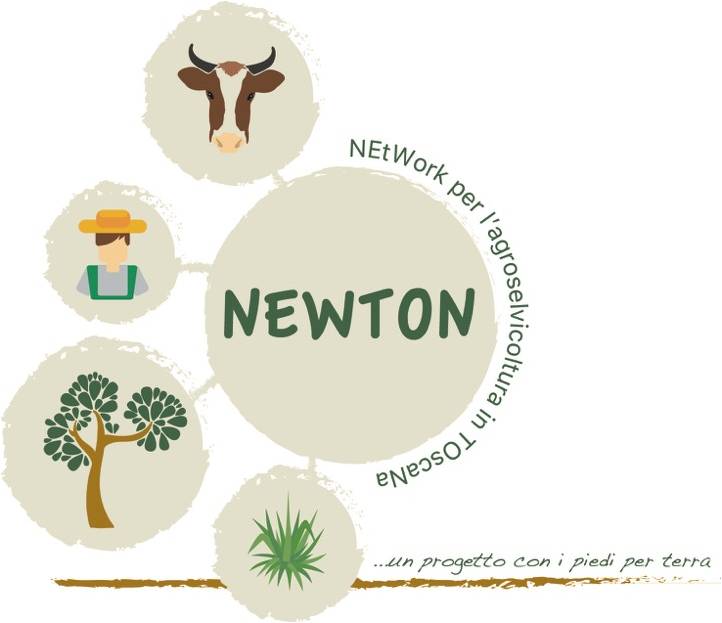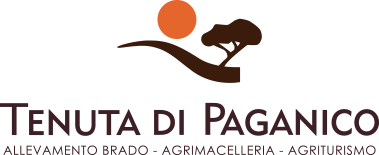Agrosilvopastoral systems in Tenuta di Paganico
Jacopo Goracci – Tenuta di Paganico Soc. Agr. SpA – Grosseto
Marcello Mele – Centro di Ricerche Agro-ambientali “E. Avanzi” – Università di Pisa
Alberto Mantino – Institute of Life Sciences – Scuola Superiore Sant’Anna – Pisa
Daniele Antichi – Centro di Ricerche Agro-ambientali “E. Avanzi” – Università di Pisa
Giorgio Ragaglini – Institute of Life Sciences – Scuola Superiore Sant’Anna – Pisa
One hundred years of history
Tenuta di Paganico is an organic extensive farm since 1924, located in the center of Maremma in central inland area of Italy (Tuscany). The farm consists of almost 1.500 ha, divided into 1.100 ha of woodland, 100 ha of pastures and 300 ha of crops, olive groves and vineyards. This territorial distribution makes immediately understand how important is the role of woods – represented by more than 70% of the total area – in the ecological and economical aspects of farm management: a deliberate association of a woody component (trees or shrubs) with animals in the same site (cattle, sheep, pigs and horses) was ever studied, promoted and applied.
Alberto Uzielli, the founder of the farm, wrote in 1938 on woods: “an increase in processing and transport costs, a reduction in the price of products and a greater risk of fire are all leading to less active and less well-tended silviculture and will also promote an extension of the use of woods area for pastoral purpose. The damage that livestock cause with the grazing to many coppices affects such poor maquis that sometimes the zootechnical profit is greater than the forest damage. (…) It would be really convenient, where possible, to try to arrange the forest in such a way as to harmonize the forestry management with the agricultural, zootechnical and perhaps even industrial economy of the area. Pasture and forest are often reconcilable”. That is valid till now, when all the traditional forestry goods – such as fuelwood, poles, timber, cork, briar, coal, wild fruit and hunting – are gradually losing their economical value. In addition, the great exodus from the countryside, with the consequent abandonment of areas previously destined to agricultural or silvo-pastoral activities, has created vast “marginal areas” left unproductive, because they are difficult to adapt to an intensive-conventional type of agriculture: in particular, in Tuscany these phenomena followed the abandonment of sharecropping contracts (Tocchini and Sottini, 1976). This reality has caused an excessive development of shrubby vegetation (Combe, 1999) and consequently a series of chain processes (i.e. fire, clearing, runoff, erosion) that limit the reform of a proper plant cover.
The agro-silvo pastoral system
In this context, the constant presence of man with his choices, is a crucial factor in guaranteeing and safeguarding the environment and animals: in fact from the 70’s there were created almost 100 ha of fire-breaks in the woods, i.e. strips of land that has been cleared of all trees, shrubs and other combustible material, providing a “fuel free” area (Lombardi et al., 2002). The innovative system created by Alberto Uzielli was to transform firebreaks into pastures with an adequate nutritional value and equipped with water ponds for animals both in pasture or woods: the purpose was to create a real ecosystem where animals can experience the forest as their natural habitat, in which man provides, thanks to a well-designed grazing plan (Uzielli, 1979), the necessary nutrients to meet animal needs for the different groups, according to the climate and the season (Geri and Sottini, 1970; Sottini and Geri, 1970). Talamucci in 1984 assumed in a study conducted in the farm that “the forest should ultimately be considered as a “sui generis” section of rotational grazing, to be properly combined, in terms of width and time, with the other resources of the territory. In fact, studies conducted in the farm showed that spontaneous vegetation has the highest burning risk if not grazed, besides strips improved with subterranean clover, for example, even not grazed, have produced less combustible material (Pardini et al., 1993). In order to innovate the production system, always following the inspiring principles of the farm, since 2016 all calves destined for fattening have been moved from free stall housing system to a free range extensive system for the whole production cycle, avoiding the use of any concrete stable: the switch to a fully extensive breeding system was due to the conviction, after years of working with free-range farming system, that this method prioritizes animal welfare the most and gives greater quality results throughout the whole production process.
Animal breeds adopted in the farm
The choice of the breed to adopt is the result of almost 15 years of observations and studies, which have led to the choice of the Maremmana breed as the best example of adaptability to the environment and the free-range farming system preferred (Bonari et al., 1980). Maremmana is a very large sized cattle, with an impressive skeletal structure and great horns: it’s a very sturdy and long-lived breed, with a high resistance to disease and parasites, showing an high adaptation to harsh environment (Lucifero et al., 1977).
Also Cinta senese pigs are reared in a free-range organic system based on pasture and integrated with organic cereals and legumes cultivated in the farm. The changes to the Common Agricultural Policy (CAP) in 1992 and the introduction of regulation 2080/92 gave a great impetus to the withdrawal of agricultural land from food production in favor of forestry and the planting of forests, also in the Tenuta di Paganico farm, also thanks to financial incentives. In fact, almost 40 ha were involved into that process of afforestation of agricultural lands, with the plantation of pine trees, walnut, oak or cherry. Also in that case, there was created an innovative system in which wooded areas have been used, after 40 years, as shelter for breeding, pregnancy and birth of pigs, thanks to their ability to provide food and a good microclimate for animals, even in the most critical phases of their lives. Also fattening pigs are involved into a programmed rotational plan strictly linked to season: green pastures affected positively n-3 linolenic acid deposits in the backfat of Tenuta di Paganico pigs (Bochicchio et al., 2012).
Finally, all the animal feed given to animals is produced and processed within the farm as an effective short supply chain production system. It’s mainly adopted homeopathic treatments, in order to promote the observation of animals and to reduce the use of drugs in breeding systems.
Future challenges
At Tenuta di Paganico agro-silvo-pastoral system is always evolving, thanks to the fruitful collaboration with various research institutions. Next step will be to study differences between different outdoor management systems: an agroforestry model based on large strips of native improved pasture and oaks, a silvopastoral system based on an oak wood and a grass-pasture rotation without tree presence. By analyzing beef daily gain, animal behaviour parameters (body temperature, heart and respiratory frequency, hair and blood cortisol level and haematic parameters), pasture characteristics and climatic trends (temperature, humidity, wind direction and velocity) will be studied how the variation of light transmittance at herbaceous layer can influence the crops, the soil moisture and animal life conditions in order to consider the effect of trees on microclimate status and their interaction with forage and cattle.
References
Bochicchio D., Comellini M., Marchetto G., Goracci J., Della Casa G. (2012). Effect of different pastures on backfat fatty acid composition in organic Cinta Senese pig. Proc. 2nd Organic Animal Husbandry Conference “Tackling the Future Challenges of Organic Husbandry”, Hamburg, Trenthorst, 12-14 sept.: 298-301.
Bonari E., Benvenuti A., Ciomei D., Senesi G. (1980). Limiti e possibilità del pascolo bovino in un bosco misto della Toscana litoranea. Primi risultati di una ricerca pluriennale. Rivista di Agronomia 14: 30-41.
Combe J. (1999). Bosco e pascolo allo stesso tempo. Rapporto annuale WSL, Antenne romande, Lausanne (CH): pp. 13.
Geri G. and Sottini E. (1970) Composizione e digeribilità in vitro dei germogli e delle foglie di alcune piante della macchia Mediterranea, Alimentazione Animale, 2: 11-24.
Lombardi P, Argenti G, Pardini A. (2001). Revegetated firebreaks management in Tuscan Maremma. Euro-Mediterranean Conference “The future of the green Mediterranean”, Alghero, 1-2 june: 100-107.
Lucifero M., Jannella G.G., Secchiari P. (1977). Origine, evoluzione, miglioramento e prospettive della razza bovina Maremmana, Ed. Edagricole, Bologna: pp. 44.
Pardini A., Piemontese S., Argenti G. (1993). Limitazione degli incendi boschivi con il pascolamento di bande parafuoco inerbite in Toscana. L’Italia Forestale e Montana, 6: 341-352.
Sottini E. and Geri G. (1970) Composizione chimica, valore nutritivo ed utilizzazione pascoliva dei germogli e delle foglie di alcune essenze tipiche della macchia mediterranea, Alimentazione Animale, 3: 27-38.
Talamucci P. (1984). Possibilità di inserimento del bosco nei sistemi foraggeri. In: Atti della Tavola Rotonda “Pascolo e bosco”, 12 Marzo, Firenze: 23-28.
Tocchini M. and Sottini E. (1976). L’utilizzazione delle aree marginali con l’allevamento bovino da carne. Aspetti agronomici, zootecnici e di gestione. 1° Azienda tipica della Maremma grossetana, Riv. Zoot. Vet., 1: 11-22.
Uzielli A. (1938). Miglioramento e valorizzazione dei cedui in Maremma. L’Alpe, Anno XXV (XVI): 3-10.
Uzielli A. (1979). Aspetti agro-forestali e zootecnici del pascolamento nel bosco, Atti Conv. A.P.D.S.A.F., 18 Novembre, Monticano, Firenze: 19-26.
Outline for the Operating Group’s Strategic Plan:
Agroforestry Network in Tuscany (NEWTON)
Agroforestry is a cropping system in which trees and/or shrubs are deliberately combined with crops and/or livestock. The operational group (OG) NEWTON “NEtWork per l’agroselvicoltura in TOscaNa” aiming at the promotion of agroforestry practices in Tuscany as strategy for the sustainable agricultural intensification (EIP-AGRI Agroforestry Focus Group – Final Report, 2018).
In the next years, sustainable cropping systems will mitigate climate change and will be also resilient to changed condition, in order to reach the objectives of economic and environmental sustainability. Sustainable agricultural strategies have to contribute to the Paris Agreement – COP21 (ratified with DDL S. 2568 – XVII Leg., on 27th of October 2016 from Senato della Repubblica Italiana) which fix the objective to reduce by 40% greenhouse gas emissions by 2030 compared to 1990.
Agroforestry systems provide several ecosystem services that may contribute to reach the aforementioned objectives such as: the carbon storage, the reduction of nutrient leaching, the improvement of the microclimate, the conservation of soil and biodiversity (Burgess et al., 2018 – FP7 project AGFORWARD, www.agforward.eu).
The OG NEWTON will promote agroforestry with a participatory transfer of the innovative knowledge among all the stakeholders in order to: (i) valorize the traditional agroforestry systems (Mantino et al., 2016) and (ii) promote innovative agroforestry systems (Mantino et al., 2017).
This objective will be reached through the transfer of knowledge and the application and dissemination of the innovations. The specific objectives of NEWTON are: (1) to create a regional network of knowledge for the agroforestry systems, (2) to develop a network of the innovations through case studies in private or public farms, (3) to disseminate knowledges and innovative strategies with a new web-platform for the agroforestry systems in Tuscany (www.newton.eu) and (4) to valorize the agroforestry productions.
A network of farmers and stakeholders will be created in order to disseminate and transfer the innovations through a participatory approach and with interactive systems such as the web-platform and ramification. WP A WP of the project will be dedicated to the constitution of the “Agroforestry school” in which seminars, meetings, courses and study visits will be used for training and information.
The project will favor the network with other European projects on the topic such as: H2020 project AFINET, the European Agroforestry Federation EURAF (www.agroforestry.eu) and European Innovation Partnership EIP-AGRI. At national level the communication among the stakeholders of the OG of different Italian regions will be favored through the National Rural Network. At regional level NEWTON will organize workshops inviting the members of other OG from Tuscany.
The innovative strategies proposed by NEWTON will be applied in four farms in Tuscany in case studies in which environmental and economic parameters will be evaluated at field scale to disseminate information about the effects of the adoption of agroforestry systems. The web-platform developed in the project will be aimed at: (i) visualizing informative maps on the presence of agroforestry systems and on the suitability of the territory for the establishment of new systems in Tuscany, (ii) favoring the interactive communication among partners and stakeholders, (iii) disseminating the project news.
Leader: Tenuta di Paganico Soc. Agr. SpA
Partner:
Tenuta di Pietratonda (GR)
Il Rinnovamento Agricolo Soc. Coop. Agr. (PI)
Centro di Ricerche Agro-ambientali “Enrico Avanzi” (CIRAA) – Università di Pisa
Scuola Universitaria Superiore Sant’Anna (PI)
Istituto di Biometeorologia (IBIMET) – Consiglio Nazionale delle Ricerche
Centro di ricerca foreste e legno – Consiglio per la Ricerca in Agricoltura e l’Analisi dell’Economia Agraria
Associazione Nazionale dei Comuni Italiani (ANCI Toscana)
Programme for Endorsement of Forest Certification schemes (PEFC Italia)

References
Burgess P.J., den Herder M., Dupraz C., Garnett K., Giannitsopoulos M., Graves A.R., Hermansen J.E., Kanzler M., Liagre F., Mirck J., Moreno G., Mosquera-Losada M.R., Palma J.H.N., Pantera A., Plieninger T. (2018). AGFORWARD PROJECT (AGroFORestry that Will Advance Rural Development) Final Report. Cranfield University: pp. 117. https://cordis.europa.eu/docs/results/613/613520/final1-agforward-final-report-28-feb-2018.pdf
EIP-AGRI Focus Group. (2017). Agroforestry: introducing woody vegetation into specialized crop and livestock systems. Final Report. pp.32. https://ec.europa.eu/eip/agriculture/sites/agri-eip/files/eip-agri_fg_agroforestry_final_report_2017_en.pdf
Mantino A., Ragaglini G., Tozzini C., Cappucci A., Mele M., Bonari E. (2016). Yield and nutritive value of alfalfa (Medicago sativa L.) in an olive alley-cropping practice. Book of Abstracts of 3rd European Agroforestry Conference, Montpellier 23-25 May.
Mantino A., Ragaglini G., Coli A., Ginanni M., Bonari E., Pelleri F., Chiarabaglio P.M., Mazzoncini M., Mele M. (2017). Sistemi silvoarabili mediterranei: nuove esperienze in campo al Centro di Ricerche Agro-ambientali “Enrico Avanzi” di Pisa – XI Congresso SISEF LA FORESTA CHE CAMBIA Ricerca, qualità della vita e opportunità in un paese in transizione – Roma 10 – 13 ottobre 2017.
ia)

